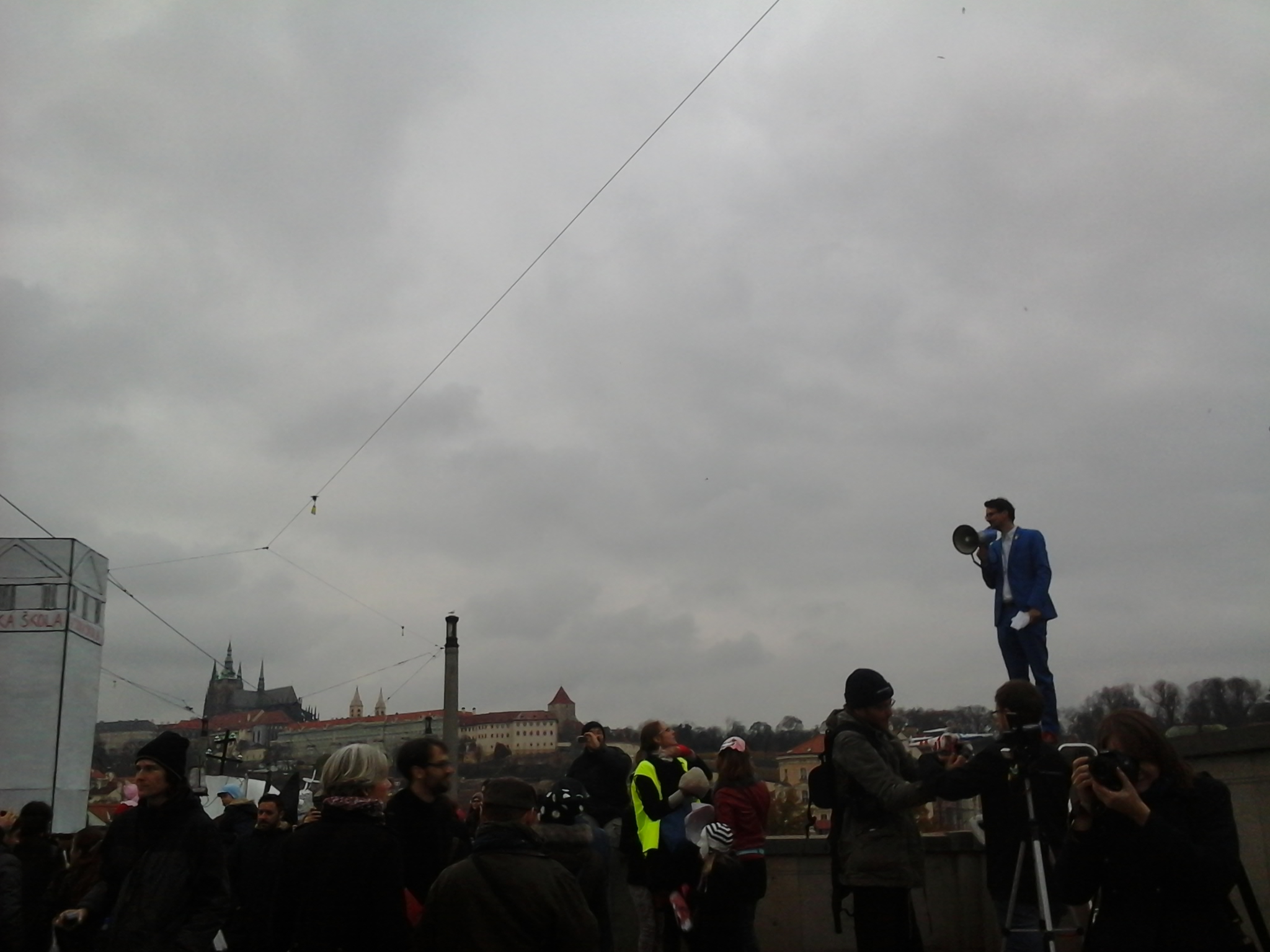The Circus
Madnesses en masse I witnessed on the streets of Prague, in the most bizarre of political protests – though one which may catch on. I believe it demonstrates not only anarchist principles, but action, and on a large scale. The public of Prague had a glimpse of an alternate political method. This is an account of the joyous approach to politics in the Czech capital.
17th November, the anniversary of the beginning of the Velvet Revolution, and solemnity finds its expression in the candles placed beneath the statue of King Wenceslas upon whose square commemorations have been taking place throughout the day. Looking down from here, perhaps in more ways than one, the foot of the boulevard boasts a more Dionysian spectacle.
A congregation of papier-mâché grotesques is gathered, ungainly costumes mounted on shoulders and covering faces loom over the public. They are elaborate, colourful and cryptic. Symbolism draws the eye and the hotdog-eating crowds. Strolling amongst them, holidaying citizens curiously, if a little apprehensively, accept proffered flyers, leaflets, petitions, posters. Children fearlessly gambol and examine – a towering bear with the face of Mr Putin is a favourite, its meaning lost on them, but becoming clear to their parents. This was a political rally, but unlike any I or they had witnessed.
At the centre of the crowd a brass band wrapped against the chill let a few preliminary notes ring out. Atop a step-ladder, bedecked in blue suit, a would-be ring-master calls through a megaphone. His clowns are assembled. Greeted by laughter the band launches into Fucik’s The Entry of the Gladiators, Putin’s paws wave, and the circus begins to march.
This was Sametové Posvícení , the Velvet Carnival. On parade were the faults of a nation. In the vanguard anthropomorphic pylons acted as puppeteers to demonstrators, masks frozen into expressions of concern. On the flanks, canvassers, seemingly fresh from a Venetian ball, made it clear this was Green Peace’s contingent, aiming to highlight (I admittedly learn in retrospect) the Republic’s fossil fuel dependence. This regimentation repeated. Forlorn primary schoolers grasp at a cardboard representation of higher education, marching out of reach. Rotund augustes stroll in dressing-gowns, feeding on crisps, holding aloft an impressive golden couch. The tentacles of a giant octopus guided masked newspaper readers, the black and white dress of convicts matching their oversized reading material. A moving tropical island, complete with Speedo-wearing effigy, followed a well-heeled politico, mirroring the deep-rooted corruption and scandal of the previous years. A tent bearing the Ukrainian flag is dragged along by Putin’s bear. Mourning babushkas communicate the injustice of imprisonment during the Communist era, others the struggles of modern day ex-cons. A flamboyant cohort of gypsies whirl past, playing fiddles under a giant bird of prey, looming, as does the state and public opinion, over the much maligned Roma population. The broad masks of children’s faces form the rear-guard, so close to being left behind.
Sounds of brass and drums accompany the marchers, guitars and violins announce their arrival at Národní třída before the dazzling colours catch eye. Moving from this artery of the city to the tourist haven of the Charles Bridge, the crowds ignore the architecture, and witness a nation beyond its attractions.
I spoke to Ondřej, the wielder of the megaphone who had begun the demonstration, and who had goaded it along its path. He explained that each of the bizarre representations of social ills was prepared by local, grassroots initiatives ‘for example, people supporting those released from prison, the homeless. Greenpeace, groups against political corruption. On Narodni we became an attraction, which was great. It’s very positive.’
‘It’s not like the protests against the president, maybe you saw the news? They were stupid.’ Indeed, there is a very different character to the headline-dominating barrage on the head of state. This march, now followed joyously by the public (even the police escort share the smiles), does not make for presidential residence. Instead, it arrives at a modest warehouse by the Vltava. ‘Here we end outside this building, it’s where the costumes were made’ Explains Ondřej. We watch as the various caricatures gather to the sound of the can-can.
This demonstration was not ‘na Hrad!’ (to the castle), as Havel was impelled by the crowds twenty-five years previous. Nor was it demanding the removal of anyone from this property. By the banks of the river, below the castle in more than a literal sense, the efforts of the demonstrators were rooted to something altogether more demotic, less high, less mighty. Self-contained were those who wished to affect change and those they wished to affect. A marching, moving manifesto, it began and ended with the passion of ordinary people, dissatisfied with societies problems, willing to affect a change without the endorsement or attacking of presidents, and brought no small amount of joy and awareness along the way.
As pylons danced the can-can, I considered the impact of such a march. Perhaps it is revelry. Perhaps this is not serious politics. Happily, its lessons are not for serious politicians. This circus’ actions declare them a lost cause. Rather, the lessons of such DIY democracy are for those who watched, who marched and who created. For the people.
Craig Simpson
Ella Harrison
Latest posts by Ella Harrison (see all)
- Migrant Lives: Not A Commodity - May 5, 2015
- Educate! Agitate! ORGANISE! - May 3, 2015
- CORPORATE WATCH APPEAL - May 3, 2015
- The Irish Brigadista - April 5, 2015
- From The Land Of Proudhon 5 - March 25, 2015










